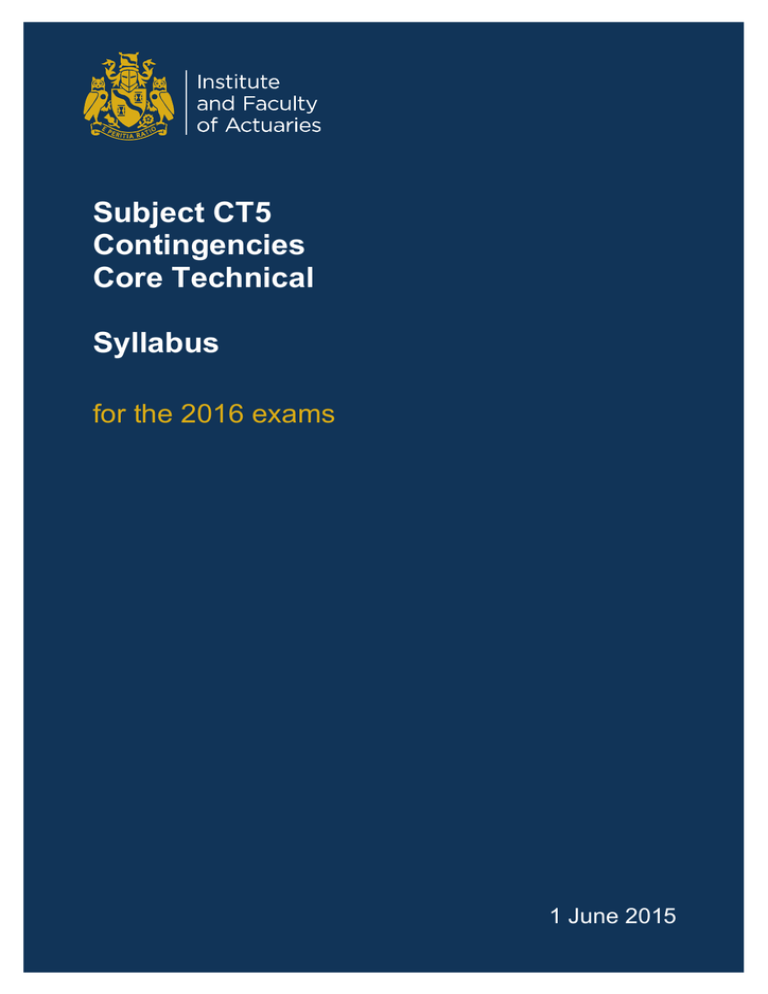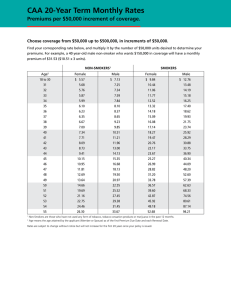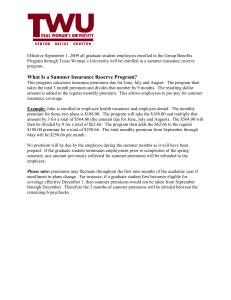Subject CT5 - Contingencies. Syllabus for the 2016 exams
advertisement

Subject CT5 Contingencies Core Technical Syllabus for the 2016 exams 1 June 2015 Subject CT5 – Contingencies Core Technical Aim The aim of the Contingencies subject is to provide a grounding in the mathematical techniques which can be used to model and value cashflows dependent on death, survival, or other uncertain risks. Links to other subjects Subjects CT1 – Financial Mathematics, CT3 – Probability and Mathematical Statistics and CT4 – Models: introduce techniques that will be drawn upon and used in the development of this subject. Subjects ST1 – Health and Care Specialist Technical, ST2 – Life Insurance Specialist Technical and ST4 – Pensions and other Benefits Specialist Technical: use the principles introduced in this subject. Objectives On completion of this subject the candidate will be able to: (i) Define simple assurance and annuity contracts, and develop formulae for the means and variances of the present values of the payments under these contracts, assuming constant deterministic interest. 1. Define the following terms: whole life assurance term assurance pure endowment endowment assurance whole life level annuity temporary level annuity guaranteed level annuity premium benefit including assurance and annuity contracts where the benefits are deferred. Page 2 2. Define the following probabilities: n|mqx , n|qx and their select equivalents n|mq[x]+r , n|q[x]+r . 3. Obtain expressions in the form of sums for the mean and variance of the present value of benefit payments under each contract above, in terms of the curtate random future lifetime, assuming that death benefits are payable at the end of the year of death and that annuities are paid annually in advance or in arrear, and, where appropriate, simplify these expressions into a form suitable for evaluation by table look-up or other means. 4. Obtain expressions in the form of integrals for the mean and variance of the present value of benefit payments under each contract above, in terms of the random future © Institute and Faculty of Actuaries Subject CT5 – Contingencies Core Technical lifetime, assuming that death benefits are payable at the moment of death and that annuities are paid continuously, and, where appropriate, simplify these expressions into a form suitable for evaluation by table look-up or other means. 5. 1 Define the symbols Ax , Ax:n , Ax:n , Ax1:n , ax , a x:n , a m x:n , ax , ax:n , m ax:n and their select and continuous equivalents. Extend the annuity factors to allow for the possibility that payments are more frequent than annual but less frequent than continuous. 6. Understand and use the relations between annuities payable in advance and in arrear, and between temporary, deferred and whole life annuities. 7. Understand and use the relations Ax = 1 dax , Ax:n = 1 dax:n , and their select and continuous equivalents. 8. (ii) (iii) Define the expected accumulation of the benefits in 1., and obtain expressions for them corresponding to the expected present values in 3. and 4. (note: expected values only). Describe and use practical methods of evaluating expected values and variances of the simple contracts defined in objective (i). 1. Describe the life table functions lx and dx and their select equivalents l[x]+r and d[x]+r . 2. Express the following life table probabilities in terms of the functions in 1.: n px , nqx , n|m qx and their select equivalents n p[x]+r , nq[x]+r , n|mq[x]+r . 3. Express the expected values and variances in objective (i) 3. in terms of the functions in 1. and 2. 4. Evaluate the expected values and variances in objective (i) 3. by table look-up or other means, including the use of the relationships in objectives (i) 6. and 7. 5. Derive approximations for, and hence evaluate, the expected values and variances in objective (i) 4. in terms of those in objective (i) 3. 6. Evaluate the expected accumulations in objective (i) 8. Describe and calculate, using ultimate or select mortality, net premiums and net premium reserves of simple insurance contracts. 1. Define the net random future loss under an insurance contract, and state the principle of equivalence. 2. Define and calculate net premiums for the insurance contract benefits in objective (i) 1. Regular premiums and annuity benefits may be payable annually, more frequently than © Institute and Faculty of Actuaries Page 3 Subject CT5 – Contingencies Core Technical annually, or continuously. Death benefits may be payable at the end of the year of death, or immediately on death. 3. State why an insurance company will set up reserves. 4. Describe prospective and retrospective reserves. 5. Define and evaluate prospective and retrospective net premium reserves in respect of the contracts in objective (i) 1., with premiums as in (iii) 2. 6. Show that prospective and retrospective reserves are equal when calculated on the same basis. 7. Obtain recursive relationships between net premium reserves at annual intervals, for contracts with death benefits paid at the end of the year of death, and annual premiums. 8. Define and calculate, for a single policy or a portfolio of policies (as appropriate): death strain at risk expected death strain actual death strain mortality profit for policies with death benefits payable immediately on death or at the end of the year of death; for policies paying annuity benefits at the start of the year or on survival to the end of the year; and for policies where single or annual premiums are payable. (iv) Page 4 Describe and calculate, using ultimate or select mortality, net premiums and net premium reserves for increasing and decreasing benefits and annuities. 1. Extend the techniques of (ii) to calculate the expected present value of an annuity, premium, or benefit payable on death, which increases or decreases by a constant compound rate. Calculate net premiums and net premium reserves for contracts with premiums and benefits which vary as described. 2. Define the symbols (IA)x , (IĀ)x , ( Ia) x , (Ia)x and (Iā)x and their select equivalents. 3. Calculate the expected present value of an annuity, premium or benefit payable on death, which increases or decreases by a constant monetary amount. Calculate net premiums and net premium reserves for contracts with premiums and benefits which vary as described. 4. Describe the operation of conventional with-profits contracts, in which profits are distributed by the use of regular reversionary bonuses, and by terminal bonuses. 5. Calculate net premiums and net premium reserves for the conventional with profits contracts defined in 4. © Institute and Faculty of Actuaries Subject CT5 – Contingencies Core Technical 6. Describe the operation of accumulating with-profits contracts, in which benefits take the form of an accumulating fund of premiums, where either: the fund is defined in monetary terms, has no explicit charges, and is increased by the addition of regular guaranteed and bonus interest payments plus a terminal bonus; or the fund is defined in terms of the value of a unit fund, is subject to explicit charges, and is increased by regular bonus additions plus a terminal bonus (“Unitised with-profits”) In the case of unitised with-profits, the regular additions can take the form of (a) unit price increases (guaranteed and/or discretionary), or (b) allocations of additional units. In either case a guaranteed minimum monetary death benefit may be applied. (v) Describe and calculate gross premiums and reserves of assurance and annuity contracts. 1. List the types of expenses incurred in writing a life insurance contract. 2. Describe the influence of inflation on the expenses listed in 1. 3. Define the gross future loss random variable for the benefits and annuities listed in (i) 1. and (iv) 1.–5., and calculate gross premiums and reserves that satisfy probabilities involving the future loss random variable. Regular premiums and annuity benefits may be payable annually or continuously. Death benefits may be payable at the end of the year of death or immediately on death. 4. Calculate gross premiums using the equivalence principle. Regular premiums and annuity benefits may be payable annually, more frequently than annually, or continuously. Death benefits may be payable at the end of the year of death or immediately on death. 5. Calculate gross premiums using simple criteria other than the principles described in 3. and 4. 6. Define and calculate the gross premium prospective reserve. 7. Define and calculate the gross premium retrospective reserve. 8. State the conditions under which, in general, the prospective reserve is equal to the retrospective reserve allowing for expenses. 9. Prove that, under the appropriate conditions, the prospective reserve is equal to the retrospective reserve, with or without allowance for expenses, for all standard fixed benefit and increasing/decreasing benefit contracts. © Institute and Faculty of Actuaries Page 5 Subject CT5 – Contingencies Core Technical 10. (vi) (vii) (viii) Obtain a recursive relation between successive annual reserves for an annual premium contract, with allowance for expenses, for standard fixed benefit contracts, and use this relation to calculate the profit earned from a contract during a year. Define and use functions involving two lives. 1. Extend the techniques of objectives (i)–(v) to deal with cashflows dependent upon the death or survival of either or both of two lives. 2. Extend the techniques of 1. to deal with functions dependent upon a fixed term as well as age. Describe and illustrate methods of valuing cashflows that are contingent upon multiple transition events. 1. Define health insurance, and describe simple health insurance premium and benefit structures. 2. Explain how a cashflow, contingent upon multiple transition events, may be valued using a multiple-state Markov Model, in terms of the forces and probabilities of transition. 3. Construct formulae for the expected present values of cashflows that are contingent upon multiple transition events, including simple health insurance premiums and benefits, and calculate these in simple cases. Regular premiums and sickness benefits are payable continuously and assurance benefits are payable immediately on transition. Describe and use methods of projecting and valuing expected cashflows that are contingent upon multiple decrement events. 1. Define a multiple decrement model as a special case of multiple-state Markov model. 2. Derive dependent probabilities for a multiple decrement model in terms of given forces of transition, assuming forces of transition are constant over single years of age. 3. Derive forces of transition from given dependent probabilities, assuming forces of transition are constant over single years of age. 4. Describe the construction and use of multiple decrement tables. 5. Describe the typical benefit and contribution structures of pension schemes, including: 6. Page 6 defined contribution schemes defined benefit (final salary) schemes Use multiple decrement tables to evaluate expected present values of cashflows dependent upon more than one decrement, including those of pension schemes. © Institute and Faculty of Actuaries Subject CT5 – Contingencies Core Technical (ix) (x) Describe and use projected cashflow techniques, where and as appropriate for use in pricing, reserving, and assessing profitability. 1. Define unit-linked contract. 2. Project expected future cashflows for whole life, endowment and term assurances, annuities, unit-linked contracts, and unitised with-profits contracts, incorporating multiple decrement models as appropriate. 3. Profit test simple annual premium contracts of the types listed in 2. and determine the profit vector, the profit signature, the net present value, and the profit margin. 4. Show how a profit test may be used to price a product, and use a profit test to calculate a premium for a conventional (without profits) life insurance contract. 5. Show how, for unit-linked contracts, non-unit reserves can be established to eliminate (“zeroise”) future negative cashflows, using a profit test model. Describe the principal forms of heterogeneity within a population and the ways in which selection can occur. 1. Explain why it is necessary to have different mortality tables for different classes of lives. 2. Explain the theoretical basis of the use of risk classification in life insurance. 3. State the principal factors which contribute to the variation in mortality and morbidity by region and according to the social and economic environment, specifically: 4. Define and give examples of the main forms of selection: 5. occupation nutrition housing climate/geography education genetics temporary initial selection class selection time selection spurious selection adverse selection Explain how selection can be expected to occur amongst individuals or groups taking out each of the main types of life insurance contracts, or amongst members of large pension schemes. © Institute and Faculty of Actuaries Page 7 Subject CT5 – Contingencies Core Technical 6. Explain the concept of mortality convergence 7. Explain how decrements can have a selective effect. 8. Explain the concept of a single figure index and its advantages and disadvantages for summarising and comparing actual experience. 9. Define the terms crude mortality rate, directly standardised and indirectly standardised mortality rate, standardised mortality ratio, and illustrate their use. END OF SYLLABUS Page 8 © Institute and Faculty of Actuaries


